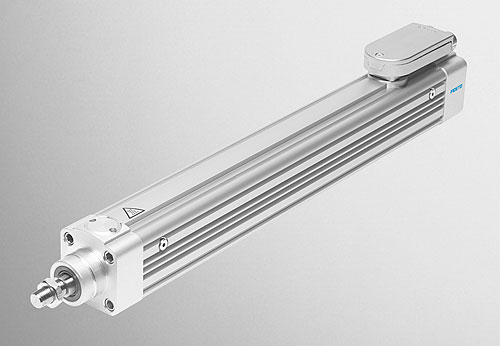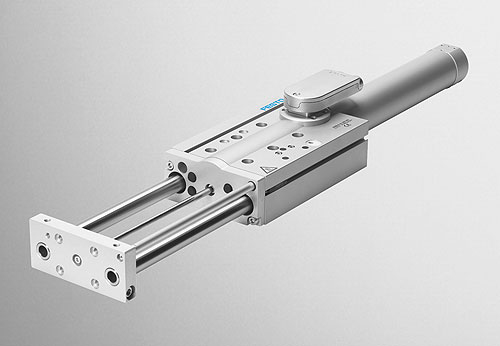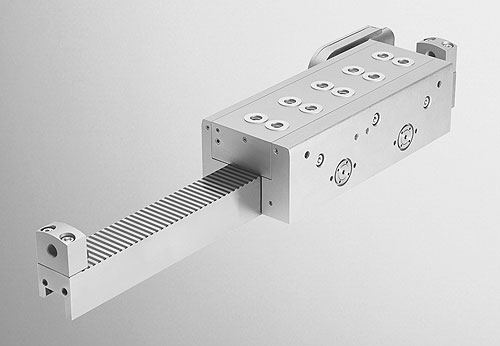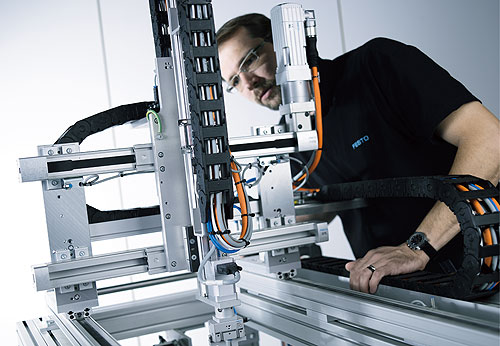With acceleration values of 140 m/s², Festo linear motor direct drives are the perfect actuators for fast acceleration with high precision, such as is required in photovoltaics production, medical technology, the electronics industry or the assembly of small parts in the clock and watch-making industry.
The electric linear motor drives ELGL-LAS, DNCE-LAS and DFME-LAS accelerate at one and a half to four times the rate of all other electric and pneumatic drives used in automation technology. They are also two to three times faster than electric axes with a spindle or belt drive. And all this to an accuracy of 10 µm. This makes linear motor axes the ideal choice for short assembly times, where not only high speeds but above all high rates of acceleration are required.

Short strokes in less than 20 milliseconds: the linear motor drive DNCE-LAS. (Photo: Festo)
Complete system
All three linear axes are supplied as complete, ready-to-use systems according to the “plug and work” principle. Together with the motor controllers SFC-LACI and CMMP-AS they enable free setting of speed, force and position, and various types of connections, such as an I/O panel or fieldbus node, as well as a measuring system, guide, reference sensor and Festo Configuration Tool (FCT) commissioning software.
DNCE-LAS and DFME-LAS
The DNCE-LAS is an electric linear motor drive. It enables positioning operations with short strokes to be carried out in less than 20 milliseconds. The guided version of this is the electric guided axis DFME-LAS. With both variants, the cylinder body houses a guide with an integrated grease reservoir. This means that both cylinders are maintenance-free and have a long service life.

Maintenance free with a long service life: the electric guided axis DFME-LAS, the guided version of the electric drive DNCE-LAS. (Photo: Festo)
Ready-to-install handling units
DNCE-LAS und DFME-LAS have the same interfaces as their pneumatic equivalents and thus fit seamlessly into the Festo modular mechatronic multi-axis system. This enables hundreds of possible combinations with other electric, pneumatic or servopneumatic drives or components for gripping, joining, turning and positioning, up to and including ready-to-install complete handling systems.
Festo’s system concept even includes a facility for customers to order complete pre-assembled individual handling units with a single part number. These units are pre-tested and supplied with all design data and circuit diagrams, together with a comprehensive functional and fixed-price guarantee, thus shortening the process from concept to machine and reducing the number of interfaces required. This saves time and money.
Flagship ELGL-LAS

The flagship among Festo’s linear motor axes: the air bearing ELGL-LAS, which offers highly dynamic positioning, both horizontally and vertically. (Photo: Festo)
The flagship among the Festo linear motor axes is the air bearing ELGL-LAS. This offers highly dynamic positioning, both horizontally and vertically. The axes can be fitted with several carriages, moving independently of one another.
Air bearings
The principle of an air bearing is based on permanent magnets that create a strong attraction between the carriage and the base of the axis. Compressed air is fed between the magnets and the base, thus creating an air cushion as a counterforce to the attraction of the magnets. The carriage lifts and can be moved free of dynamic friction.

Complete pre-assembled individual handling units: these shorten the process from concept idea to machine and reduce the number of interfaces required. This saves time and money. (Photo: Festo)
The air bearing of the linear motor axis ELGL-LAS with its magnetic bias makes the axis more precise and torsionally rigid and at the same time ensures that it is unaffected by dry dirt particles. The axis is thus resistant to wear and maintenance-free. Once the air bearing is switched off, the magnetic bias acts like a holding brake. It can hold a load mounted on the axis at a standstill. The air bearing does not create any strong external magnetic fields.
Back to the principle of a linear motor drive: the drive of the Transrapid is also a linear motor. This gives a top speed of 501 km/h.
Festo
www.festo.com
Filed Under: Factory automation, Motors (linear), LINEAR MOTION, Motion control • motor controls, Motors (direct-drive) + frameless motors





Tell Us What You Think!